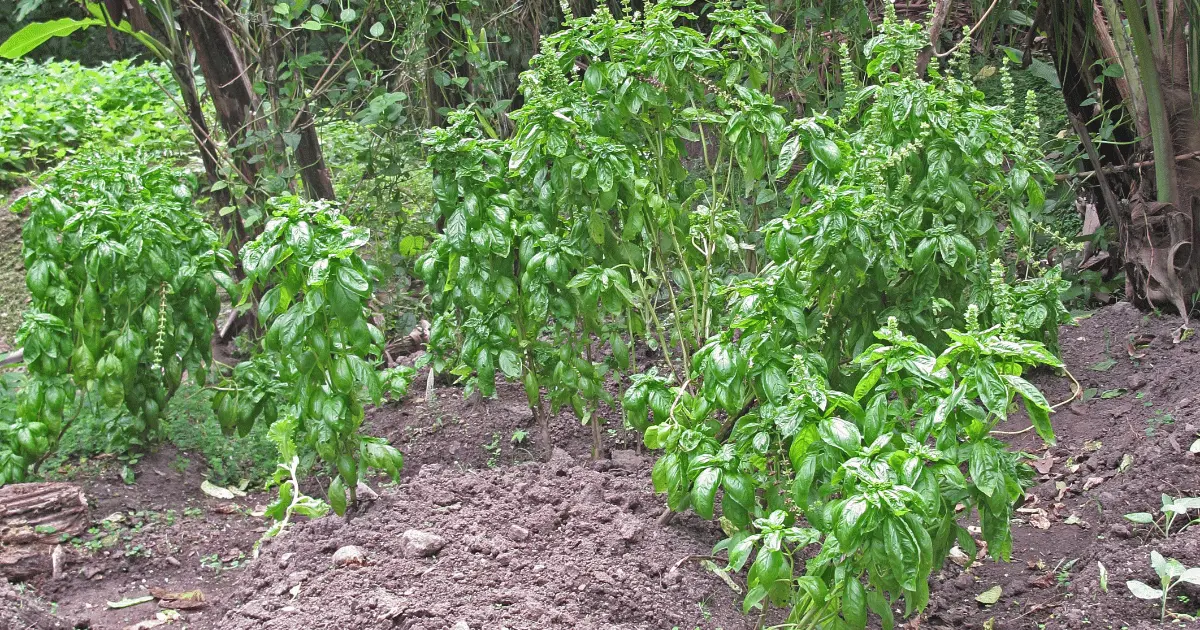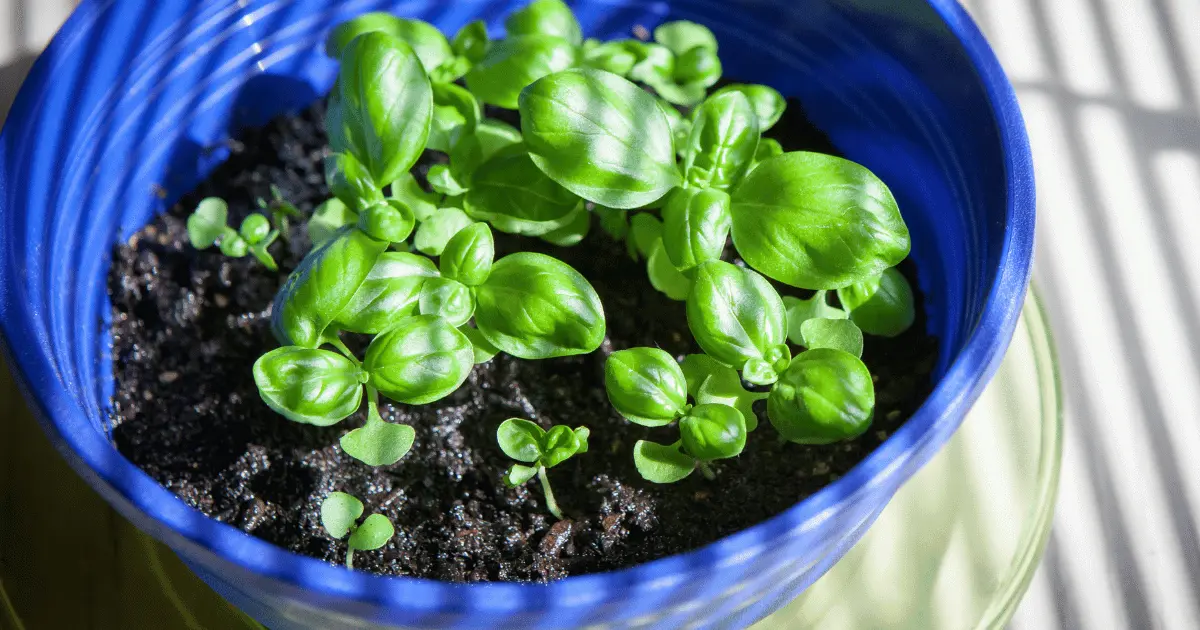Basil easily tops the list if you ask me about my favorite herbs. This is because Basil is easy to grow and adds a distinct flavor to many foods, including soups, salads, pasta, and more. I enjoy growing Basil as much as I enjoy growing cucumbers.
When sowing Basil seeds, you should space them approximately a third of an inch apart. You will need to thin the seeds as they germinate and transplant the seedlings as they grow so that they are four to eight inches apart. If you want to learn how to space your Basil, read on properly!
How to Space Your Basil

As earlier stated, if you are sowing your Basil as a seed, you should space them ⅓ of an inch apart. Remember that as your seeds grow, you must thin them four to eight inches apart. Thinning is one of the best ways to ensure that only your strongest plants survive. If you are following square-foot gardening, four plants should be planted for each square foot of garden soil. If you want, you can also plant one Basil plant for each square foot of garden soil.
Per square feet of gardening soil, strive for four basil plants for the best growth outcomes. Without crowding the plants, the tightness will hold them upright. All plants will have adequate space and light to grow while developing. Additionally, each basil plant will have good soil for root development due to the thin root ball of basil plants. In growing vegetables such as tomatoes or Basil, overcrowding will hinder your yield.
For continued growth, a basil plant needs around four inches of space and four inches of depth. When basil plants are crammed together, one plant may flourish while the others struggle. Another issue with overcrowding basil plants is that they will all continue to grow stunted.
Spacing Basil in Containers

Basil can be grown just about anywhere. Any container, such as a laundry basket, would do. Basil prefers space so that the plants can breathe. It would help if you used a big pot because it also hates to dry out entirely. Although it’s best to keep plants at least 12 to 18 inches apart, you can place them closer if your container is intended for aesthetics and functionality. Try spacing them out more like 6 to 8 inches. However, because Basil is susceptible to fungus, it’s crucial to maintain airflow between plants.
Starting basil plants from seed is simple. You can direct or start your seeds indoors about a month before your last frost date. Remember that you should place them outside around two weeks following the latest frost date in your area.
Plant the seeds only 1/4 inch deep because Basil needs light to germinate. Although you have some flexibility with the temperature, temperatures around 70 degrees Fahrenheit are ideal. Within five to ten days, seeds will begin to sprout. When plants have three to four sets of leaves, carefully transplant them.
Tips For Growing Basil
There are some essential tips to follow when you are growing your Basil. Whether you grow these herbs in a container or garden bed, some tips will aid you in getting the best result.
- Moist Soil
Basil prefers wet soil. It can be tricky to keep them consistently moist without drowning them in water. Basil’s growth can be stunted by mildew and rot brought on by overwatering. Basil grown in containers needs to be watered more frequently since the soil dries out more quickly.
- Follow-up Planting
Succession planting is popular among gardeners for crops like salad greens or bush beans, but Basil is often overlooked. Since flavour quality does decrease with flowering, Basil is the ideal plant for succession planting. You can continue to enjoy wonderful Basil from late April until the first October frost by planting multiple harvests each season.
- Pinching
The greatest approach to encourage rapid growth in your basil plants is to pinch them, which you can do by regularly harvesting. To maintain Basil’s top flavour, most gardeners also pinch off flower buds as they bud, but those blossoms are particularly alluring to bees and other useful insects.
- Proper Fertilization
Like other plants, basil gains from an increase in nutrients; for indoor plants, fertilize your basil plants every four to six weeks, and for outdoor plants, every two to three weeks. To increase leaf output, use a fertilizer that is evenly formulated with nitrogen, potassium, and phosphate.
- Early Harvest
Basil should be harvested as early as possible and on a weekly or biweekly basis for the rest of the season. It’s time to prune if you see flower buds forming on your mature plant. If this does not occur, the plant will focus on producing seeds rather than more of its foliage. Additionally, Basil’s flavour alters with flowering. If you’re too late and the flowers have already begun to bloom, pinch off the edible flower heads.
It can be tempting to harvest your Basil in excess, but it’s best only to take twenty percent of the plant each time. If you leave enough leaves on your plant, it will help it grow more quickly.
What Does a Basil Need To Grow?
Even though I find Basils incredibly easy to grow, some farmers still struggle to grow them. A few things are necessary for Basil’s growth; in the next paragraphs, I will highlight a few.
- Heat
One error that gardeners make is setting out their basil plants too early. Although you might believe that heat and sunlight work together, that is only sometimes the case in the spring. Basil is a warm-season herb that thrives in temperatures between 80 and 90 degrees Fahrenheit.
When temperatures are consistently above 60 degrees Fahrenheit, and the risk of spring frost has passed, plant it outside. Basil suffers severe damage and develops blackened leaves when soil and air temperatures fall below 50 degrees Fahrenheit.
- Sun
Now that you know sun and heat doesn’t usually go hand in hand, you need to know how many hours of sunlight your Basil plant needs to thrive. Basil needs at least 6 to 8 hours a day of direct sunlight for healthy growth. Basil does benefit from a little midday shade in Southern locations where the sun is fierce, and the temperatures can soar.
- Moisture
Your Basil plant needs regular moisture for it to grow. Basil enjoys steady wetness but not constant moisture as other plants do. One of the quickest ways to kill your Basil is to overwater it. Your Basil prefers a constant supply of moisture but will prefer not to sit on soggy ground.
Therefore, check the soil’s moisture content with your finger before watering. Do not water if the earth seems wet unless it has been rainy or cool.
